On the road from Mysore to Coorg, just short of the town of Kushalnagar, is Bylakuppe, an area that houses one of the largest Tibetan settlements in India. Established by the Indian government in the early 1960’s to accommodate some of the thousands of refugees who had fled to India, it is today home to several generations of Tibetans in exile.
As far back as I can remember, Bylakuppe was always a point of particular interest on the journey to and from Coorg. The neat patchwork of fields on a gently undulating landscape contained relatively unusual crops for the area – tobacco, cotton, and corn. Colourful bunting, which I eventually learned were Tibetan prayer flags, fluttered above small cottages. Tibetan ladies, dressed in their traditional fashion, raked drying corn cobs on sunny rooftops. These were, for the most part, just brief vignettes as we drove by on the highway, always with somewhere else to be.
It’s not that we didn’t stop by at all. My aunt and uncle who lived in Kushalnagar had friends there, and took us to visit the “camp”, as the settlement was known. I recall visiting a weaving centre, where traditional Tibetan woolen carpets were woven. Somewhere in the family albums is a picture of myself as a tubby young girl, swaddled in a stylised version of the Tibetan chuba. ( I must ask about that!)
“Have you seen The Golden Temple?”*
Many years later, on a freezing winter morning at the Vancouver farmer’s market, I met Tsezom Yuthok, the lovely lady who, along with her sister, runs Great Himalaya Foods. They make a delicious traditional Tibetan cereal, Tsampa, from locally grown organic barley. In the course of conversation, she mentioned having visited “the Golden Temple” in Bylakuppe and how beautiful it was. I confessed that I hadn’t visited it, despite having passed that way so many times over the years. I said I’d definitely plan a visit there.
Not long after that, at a Tibetan New Year celebration in Vancouver last year, I was seated at a table alongside a chatty lady, who, as it turned out, had lived for several years in Bylakuppe. She still has family there, and visits regularly. “Have you seen the Golden Temple?” she asked. I had to admit again that I hadn’t. “It’s beautiful, you should go see it.” I said I would.
Do you sometimes find yourself passing over something simply because it’s virtually in your backyard? That place you’ve been meaning to visit, but never quite got around to? That’s definitely been something I’ve been guilty of. So, earlier this year, I made good on those intentions and made a brief visit to the Namdroling Monastery.
Stepping through the gateway to the monastery complex really was like entering another world, where gilded pagodas from the Himalayas share the sky with tropical coconut palms. Groups of monks walked briskly along the pathways, stopping to bow and chant in unison at the threshold of a shrine, before moving on to the next.
There are several temples within the complex, the two largest being the Zangdog Palri, and the Padmasambhava Buddhist Vihara, which is popularly known as “the Golden Temple”. Built in the classical Tibetan Buddhist style, they house magnificent gilded statues of the Buddha, the tallest of which is 60 feet high. Gorgeous silk brocade hangings and dramatic murals, depicting mythological subjects, cover the walls. These vivid images in deep, saturated colours draw you in, even as the quiet serenity of the space creates a sense of meditative calm.
Perhaps we were lucky in the time we chose to visit, because there were only a few other visitors around. Walking through the gardens, watching the golden rooftops catch the evening sun and diffuse it onto everything around in a warm, glowing light, we knew we’d be back to visit again.
Now, when I’m asked, “Have you seen the Golden Temple at Bylakuppe?”, I can answer, “yes, and it is beautiful!”
*The Padmasambhava Buddhist Vihara, popularly known as “the Golden Temple” is one of sixteen temples situated in the Namdroling monastery complex in Bylakuppe.

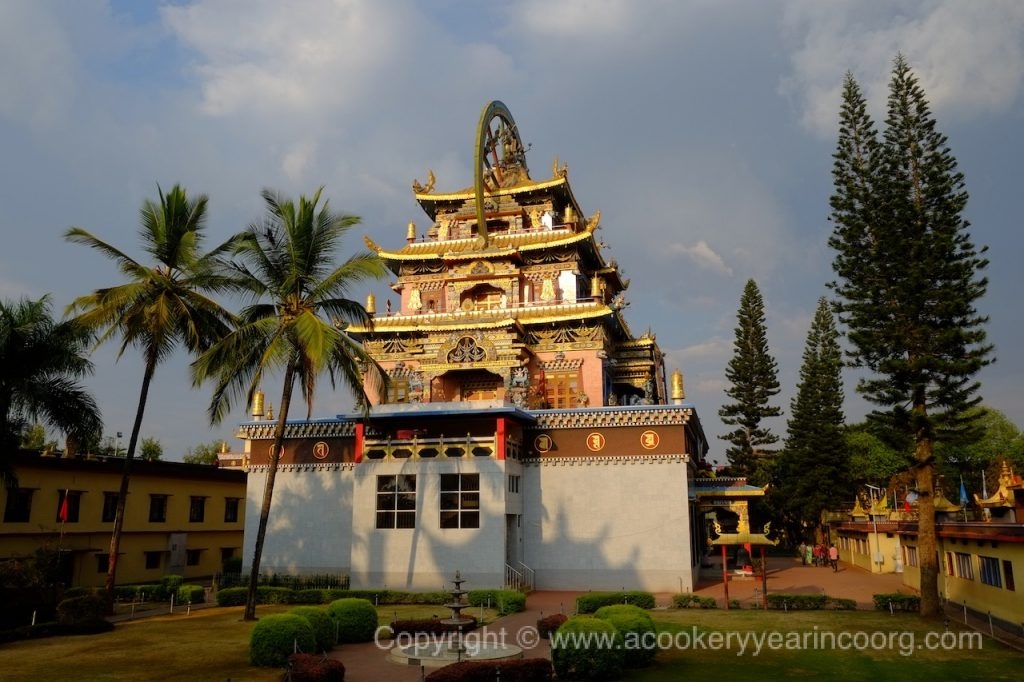
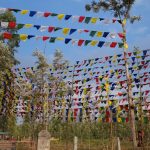


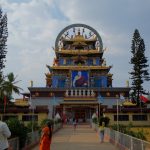
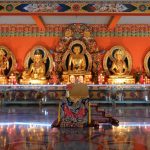
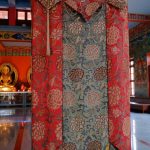
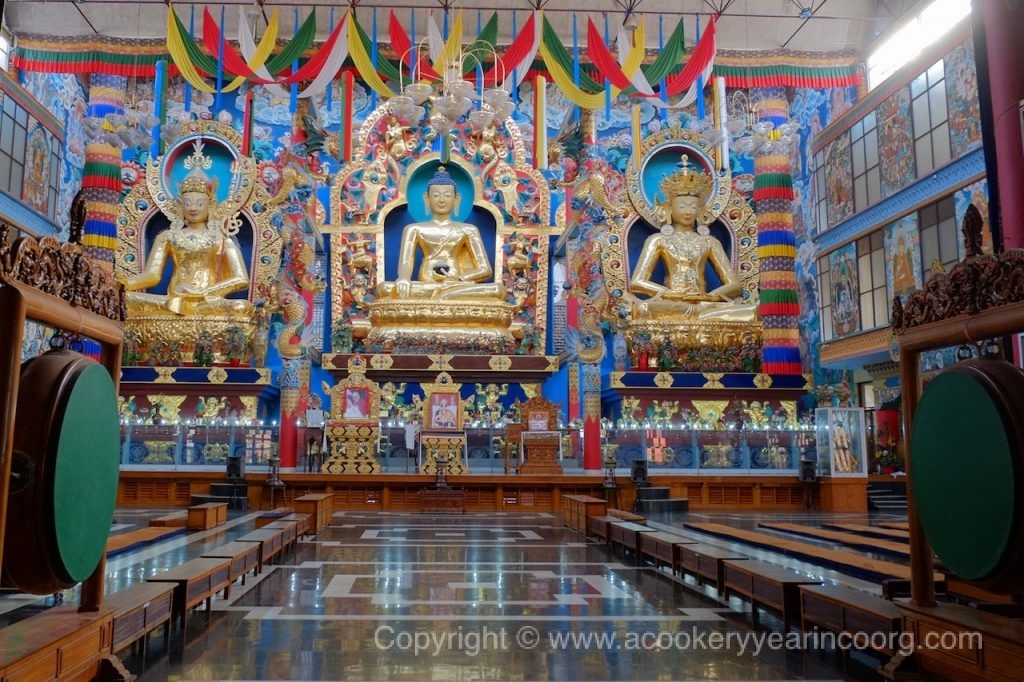
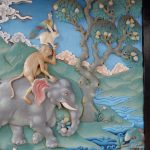
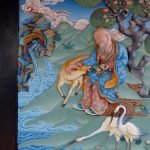


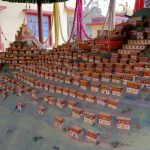
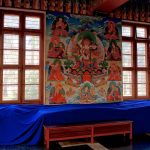
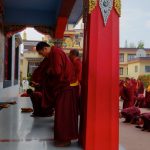
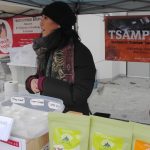
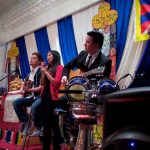
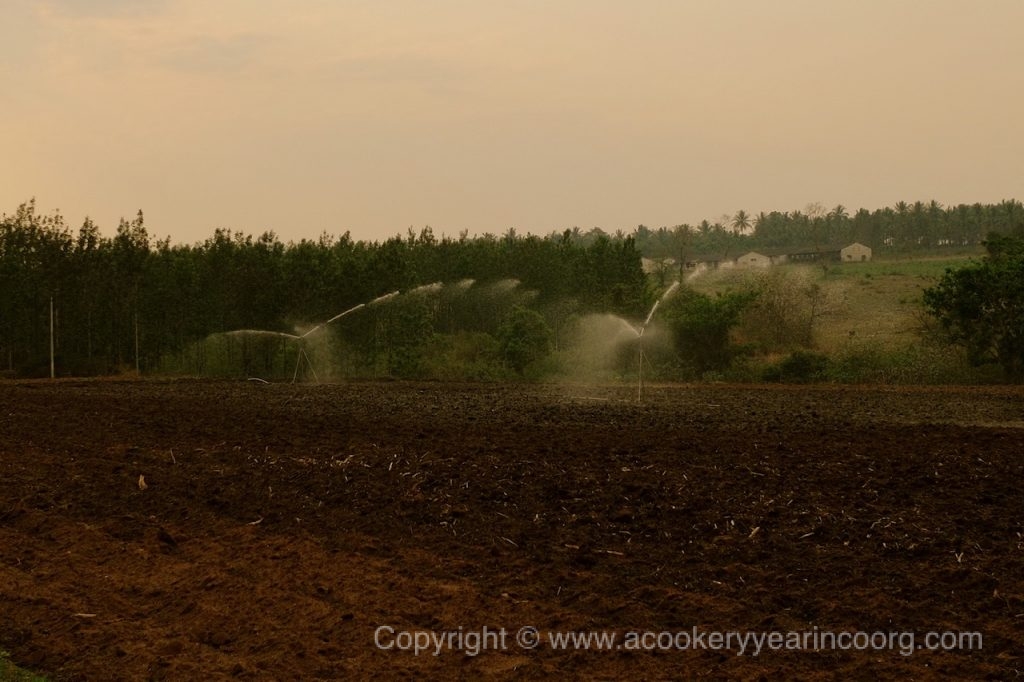
Today, June 2, just happens to be Saka Dawa Duechen, the Buddha Purnima or Buddha Jayanti according to the Tibetan Calendar, celebrated one month after the purnima is Vaishakha.
Actually, the whole intervening month is especially holy, a sort of prolonged celebration of the Birth, Enlightenment and the Mahaparinirvana of the Lord Shakyamuni.
This is how Christmas should be celebrated, over one month, Diwali too!! Hands up, those who agree!
Of course, in Bangabhumi, bengal, where I come from, the entire year is one long holiday, at least as far as the government offices are concerned!
Dear Shalini, your Tibetan friends will be delighted if you surprised them by remembering the Birthday of His Holiness the Dalai Lama, the sixth day of the sixth month of the Tibetan calendar, but now celebrated July6 worldwide each year. They will have a morning service at each of the various Tibetan monasteries in Vancouver, and that is followed by a picnic, where all are invited to attend free of cost. If a weekday, the picnic is held on a suitable weekend. If you bring a small dish to pass, people will love you, but love you they will, anyway. Do go once in your life and enjoy the festivities and the cheer.
I am sad that more Indians do not participate, and in the right spirit, without patronizing. Neither do we try to learn more deeply about the cultures that impinge so deeply upon our own futures> Rather, the vast mass of our citizenry are mesmerized by the idiocies of a few garbage film actors and sports personalities to the exclusion of any worhtwhile cultural activities. What a coarsening of our national character there has been since 1950. If a murrain carried off 90% of Indians today, myself included, I should not be sorry.
Hi Gautam,
I hope that’s tongue firmly in cheek about extending the Christmas and Diwali celebrations!
So true about the general attitude. Far too many of the folks who turn out to visit places like this, manage to remain oblivious of the beauty, let alone respect the sanctity of the monastery and respect the culture. .
I’ll ask about the July 6 events. If possible this year, I would love to participate.
🙂